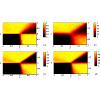当前位置:
X-MOL 学术
›
Phys. Rev. E
›
论文详情
Our official English website, www.x-mol.net, welcomes your feedback! (Note: you will need to create a separate account there.)
Lying on networks: The role of structure and topology in promoting honesty
Physical Review E ( IF 2.4 ) Pub Date : 2020-03-13 , DOI: 10.1103/physreve.101.032305 Valerio Capraro , Matjaž Perc , Daniele Vilone
Physical Review E ( IF 2.4 ) Pub Date : 2020-03-13 , DOI: 10.1103/physreve.101.032305 Valerio Capraro , Matjaž Perc , Daniele Vilone

|
Lies can have a negating impact on governments, companies, and the society as a whole. Understanding the dynamics of lying is therefore of crucial importance across different fields of research. While lying has been studied before in well-mixed populations, it is a fact that real interactions are rarely well-mixed. Indeed, they are usually structured and thus best described by networks. Here we therefore use the Monte Carlo method to study the evolution of lying in the sender-receiver game in a one-parameter family of networks, systematically covering complete networks, small-world networks, and one-dimensional rings. We show that lies that benefit the sender at a cost to the receiver, the so-called black lies, are less likely to proliferate on networks than they do in well-mixed populations. Honesty is thus more likely to evolve, but only when the benefit for the sender is smaller than the cost for the receiver. Moreover, this effect is particularly strong in small-world networks, but less so in the one-dimensional ring. For lies that favor the receiver at a cost to the sender, the so-called altruistic white lies, we show that honesty is also more likely to evolve than it is in well-mixed populations. But contrary to black lies, this effect is more expressed in the one-dimensional ring, whereas in small-world networks it is present only when the cost to the sender is greater than the benefit for the receiver. Last, for lies that benefit both the sender and the receiver, the so-called Pareto white lies, we show that the network structure actually favors the evolution of lying, but this only occurs when the benefit for the sender is slightly greater than the benefit for the receiver. In this case again the small-world topology acts as an amplifier of the effect, while other network topologies fail to do the same. In addition to these main results we discuss several other findings, which together show clearly that the structure of interactions and the overall topology of the network critically determine the dynamics of lying.
中文翻译:

躺在网络上:结构和拓扑在促进诚实中的作用
谎言会对政府,公司和整个社会产生负面影响。因此,在不同的研究领域中,了解说谎的动态至关重要。虽然以前在杂乱无章的人群中研究过说谎,但事实是,真正的互动很少混在一起。实际上,它们通常是结构化的,因此最好由网络来描述。因此,在这里,我们使用蒙特卡洛方法研究一参数网络家族中发送者-接收者游戏中的谎言演化,系统地覆盖完整的网络,小型世界网络和一维环。我们证明,骗取发送者利益而使接收者付出代价的谎言,即所谓的“黑谎言”,在网络上扩散的可能性要比在混杂人群中的传播可能性小。因此,诚实更有可能发展,但只有当发送者的收益小于接收者的成本时,才可以。此外,这种影响在小世界网络中尤为明显,而在一维环网中则不那么明显。对于偏爱接收者而不是发送者付出代价的谎言,即所谓的利他的白色谎言,我们表明,诚实度也比混合好的人群更容易发展。但是,与黑谎言相反,这种效果在一维环网中更为明显,而在小世界网络中,只有当发送方的成本大于接收方的收益时,这种影响才会出现。最后,对于有利于发送者和接收者的谎言,即所谓的Pareto白色谎言,我们证明了网络结构实际上有利于说谎的发展,但这仅在发送者的利益大于接收者的利益时才会发生。在这种情况下,小世界拓扑仍然可以起到这种作用的放大作用,而其他网络拓扑则无法做到这一点。除了这些主要结果之外,我们还讨论了其他一些发现,这些发现共同表明相互作用的结构和网络的整体拓扑结构决定了躺卧的动态。
更新日期:2020-03-16
中文翻译:

躺在网络上:结构和拓扑在促进诚实中的作用
谎言会对政府,公司和整个社会产生负面影响。因此,在不同的研究领域中,了解说谎的动态至关重要。虽然以前在杂乱无章的人群中研究过说谎,但事实是,真正的互动很少混在一起。实际上,它们通常是结构化的,因此最好由网络来描述。因此,在这里,我们使用蒙特卡洛方法研究一参数网络家族中发送者-接收者游戏中的谎言演化,系统地覆盖完整的网络,小型世界网络和一维环。我们证明,骗取发送者利益而使接收者付出代价的谎言,即所谓的“黑谎言”,在网络上扩散的可能性要比在混杂人群中的传播可能性小。因此,诚实更有可能发展,但只有当发送者的收益小于接收者的成本时,才可以。此外,这种影响在小世界网络中尤为明显,而在一维环网中则不那么明显。对于偏爱接收者而不是发送者付出代价的谎言,即所谓的利他的白色谎言,我们表明,诚实度也比混合好的人群更容易发展。但是,与黑谎言相反,这种效果在一维环网中更为明显,而在小世界网络中,只有当发送方的成本大于接收方的收益时,这种影响才会出现。最后,对于有利于发送者和接收者的谎言,即所谓的Pareto白色谎言,我们证明了网络结构实际上有利于说谎的发展,但这仅在发送者的利益大于接收者的利益时才会发生。在这种情况下,小世界拓扑仍然可以起到这种作用的放大作用,而其他网络拓扑则无法做到这一点。除了这些主要结果之外,我们还讨论了其他一些发现,这些发现共同表明相互作用的结构和网络的整体拓扑结构决定了躺卧的动态。


























 京公网安备 11010802027423号
京公网安备 11010802027423号